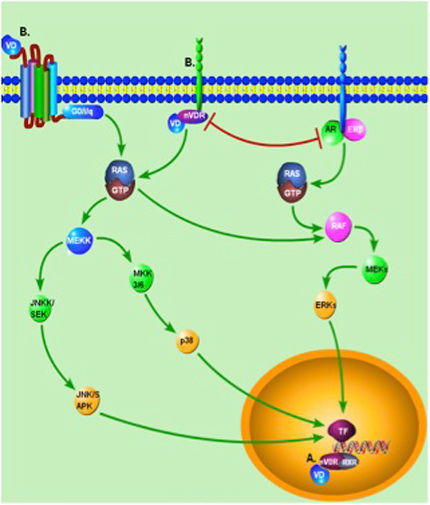
Vitamine D en prostaatkanker*
Een Zweedse studie laat zien hoe de antikankeractiviteit van vitamine D werkt bij prostaatkanker. Vitamine D onderdrukt de progressie van de ziekte en voorkomt tumorgroei en uitzaaiingen. Goede bloedwaarden vitamine D zijn daarom belangrijk bij prostaatkanker.
Vitamin D and prostate cancer: The role of membrane initiated signaling pathways in prostate cancer progression, by Sandra Karlsson, et al.
BERKELEY, CA (UroToday.com) - Accumulating evidence indicates that one of the active vitamin D metabolites, 1α,25-dihydroxyvitamin D3 (1,25(OH)2D3), possesses anti-cancerous properties and suppresses prostate cancer progression by inhibition of tumor growth and
metastasis.
The underlying mechanisms of growth inhibition by 1,25(OH)2D3 appear to be multifactorial, but documented effects are to increase differentiation of prostatic epithelial cells, stimulate apoptosis and to inhibit invasive and migratory properties.
Two signaling pathways for 1,25(OH)2D3 have been identified. 1,25(OH)2D3 operates through pharmacologically distinct nuclear receptor-mediated and plasma membrane-initiated mechanisms. It is now widely accepted that 1,25(OH)2D3 rapidly (within seconds to minutes) induces events normally associated with membrane-initiated signaling, and there is now strong evidence for 1,25(OH)2D3 mediated signal transduction, initiated at the plasma membrane in several cell types.
The nature of the membrane-initiated effects observed after exposure to 1,25(OH)2D3 have been under debate. The general view today is that the membrane-initiated effects are mediated by specific membrane associated receptors/proteins. There are currently two main candidates for a putative membrane receptor, i.e. protein disulfide isomerase family A, member 3 (PDIA3) and nuclear vitamin D receptor (nVDR), where PDIA3 bears no sequence similarity to nVDR. Structure and function studies with conformation restricted analogs of 1,25(OH)2D3 have confirmed that the 6-trans conformation of 1,25(OH)2D3 is preferable for interaction with the G-pocket of the nVDR and the 6-cis restricted analogs largely interact with the A-pocket of PDIA3 or nVDR.
In our study, we presented an overview of membrane initiated signaling of 1,25(OH)2D3 in prostate cancer cells. Furthermore, in the study we investigated the presence and partially characterized the previously identified membrane receptor, PDIA3, in prostate cancer cells.
PDIA3 was expressed in all prostate cell lines investigated (LNCaP, PC3 and PNT-2). The nVDR were localized in the nucleus, cytosol and in close vicinity to the plasma membrane. Thus, both nVDR and PDIA3 are expressed by prostate cells and could function as membrane receptors. In silico modeling revealed that PDIA3 is present as a trimer, forming a complex. The PDIA3 complex expresses six high affinity ligand-binding pockets for 1,25(OH)2D3 (two ligand-binding pockets per PDIA3) according to the in silico analysis. We could also demonstrate that membrane initiated signaling by 1,25(OH)2D3 in prostate cells activated the JNK/SAPK MAPK signaling pathway, which is involved in regulating migration, proliferation and apoptosis (Figure 1). Furthermore, prostate cells treated with 1,25(OH)2D3, where the JNK/SAPK have been inhibited, showed effects on both apoptosis and migration.
Using traditional pharmacological approaches to study the effects of 1,25(OH)2D3, introduces a difficulty to predict the physiological responses observed, as the underlying mechanisms are highly complex. To resolve these problems, we use a combination of in silico techniques with traditional pharmacological and physiological methods. This approach enables in silico predictions in the model system, which can be used to improve the designs of the in vitro studies as well as designing i.e. antagonists or agonists that block or activate a specific pathway. Results from the in vitro experiments may be used as feedback for improving the model. With a combinatory approach, a model can be created that can be shared among scientists, where components of a specific signaling pathway, with interacting nodes, can be studied in detail.
In summary, our findings suggest that 1,25(OH)2D3 is an important therapeutic agent for prostate cancer that could be used to slow down the disease progression. Furthermore, our data show that 1,25(OH)2D3 regulate prostate cell biology via multiple pathways and targeting specific pathways for 1,25(OH)2D3 might provide more effective therapies compared to the vitamin D therapies currently clinically tested and may serve as a complementary treatment in patients with androgen independent prostate
cancer.

Figure 1. A proposed mechanism of 1,25(OH)2D3 activity in prostate cells. A. 1,25(OH)2D3 is transported into prostate cells. Binding of 1,25(OH)2D3 to the cytosolic/nuclear nVDR causes nVDR to heterodimerize with the retinoid X receptor (RXR). The nVDR-RXR heterodimer binds to specific vitamin D response elements in the promotor region of vitamin D responsive genes and induces gene transcription. B. 1,25(OH)2D3 binds to a membrane-associated (nVDR) or an integral/associated membrane receptor (PDIA3). Binding of 1,25(OH)2D3 to the membrane receptor causes activation of the JNK/SAPK MAPK cascade. Activation of SAPK/JNK induces transcription of factors that affect migration, proliferation and
apoptosis.
Written by:
Dennis Larsson, Dan Lundh and Sandra Karlsson as part of Beyond the Abstract on UroToday.com. This initiative offers a method of publishing for the professional urology community. Authors are given an opportunity to expand on the circumstances, limitations etc... of their research by referencing the published abstract. (Juli 2011)
Reacties: